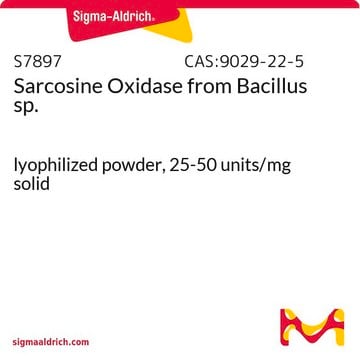S7672
Sarcosine
≥98%, suitable for HPLC, BioXtra
Synonym(s):
N-Methylglycine
About This Item
Recommended Products
product name
Sarcosine, BioXtra
product line
BioXtra
Assay
≥98%
form
powder
technique(s)
HPLC: suitable
impurities
≤0.0005% Phosphorus (P)
≤0.1% Insoluble matter
ign. residue
≤0.1%
color
white
mp
208-212 °C (dec.) (lit.)
solubility
H2O: 1 M, clear, colorless
anion traces
chloride (Cl-): ≤0.5%
sulfate (SO42-): ≤0.05%
cation traces
Al: ≤0.0005%
Ca: ≤0.0005%
Cu: ≤0.0005%
Fe: ≤0.001%
K: ≤0.005%
Mg: ≤0.0005%
NH4+: ≤0.1%
Na: ≤0.05%
Pb: ≤0.001%
Zn: ≤0.0005%
application(s)
cell analysis
SMILES string
CNCC(O)=O
InChI
1S/C3H7NO2/c1-4-2-3(5)6/h4H,2H2,1H3,(H,5,6)
InChI key
FSYKKLYZXJSNPZ-UHFFFAOYSA-N
Looking for similar products? Visit Product Comparison Guide
Application
- Glyphosate resistance and biodegradation by Burkholderia cenocepacia CEIB S5-2.: This study explores the role of sarcosine in glyphosate resistance and biodegradation by Burkholderia cenocepacia CEIB S5-2, highlighting its potential in environmental biotechnology (Díaz-Soto et al., 2024).
- CYP116B5-SOX: An artificial peroxygenase for drug metabolites production and bioremediation.: Sarcosine is utilized in developing a novel artificial peroxygenase, enhancing bioremediation and drug metabolite production applications (Giuriato et al., 2024).
Storage Class Code
11 - Combustible Solids
WGK
WGK 1
Flash Point(F)
Not applicable
Flash Point(C)
Not applicable
Personal Protective Equipment
Certificates of Analysis (COA)
Search for Certificates of Analysis (COA) by entering the products Lot/Batch Number. Lot and Batch Numbers can be found on a product’s label following the words ‘Lot’ or ‘Batch’.
Already Own This Product?
Find documentation for the products that you have recently purchased in the Document Library.
Customers Also Viewed
Our team of scientists has experience in all areas of research including Life Science, Material Science, Chemical Synthesis, Chromatography, Analytical and many others.
Contact Technical Service












